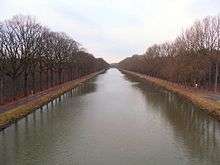Bocholt–Herentals Canal
The Bocholt–Herentals Canal (Also known locally as the Kempisch Kanaal or the Maas-Scheldekanaal) is a canal in Belgium that links the Zuid-Willemsvaart at Bocholt with the Albert Canal in Herentals, with a length of slightly over 60 kilometres. It is one of the seven canals linking the rivers Meuse and Scheldt.
| Bocholt–Herentals Canal | |
|---|---|
| Specifications | |
| Locks | 7 |
| History | |
| Principal engineer | Kümmer |
| Construction began | 1843 |
| Date of first use | 1846 |
| Geography | |
| Start point | Bocholt |
| End point | Herentals |

During the Second World War the canal was an important launch point for Operation Market Garden.
History
The canal was created as part of the link from the river Scheldt to the Meuse that Napoleon Bonaparte planned as the Grand Canal du Nord, but only the stretches Lommel-Beringen en Venlo-Neuss were built, with a part of the present Zuid-Willemsvaart between Lanaken and Bocholt.[1]
Linking the Scheldt with the Meuse remained important though, to serve the heavy industry in and around Liège. The 1807 Treaty of Fontainebleau added Lommel to the national territory, in exchange for Luyksgestel, this removed the last obstacle. The canal was created by one Kümmer starting in 1843, construction took three years. The canal connected to the Zuid-Willemsvaart near Bocholt and to the river Nete near Herentals. Apart from its transportation function, the canal also served to irrigate the dry Kempen region with water from the Meuse.
The canal was enlarged, both in width and in draught, in 1928. As a link between Scheldt and Meuse, the canal lost much of its importance when the Albert Canal was opened in 1940: this was shorter and faster, and offered greater capacity. Some industry had already been settled however, and was to stay: one example is the Umicore (Union Minière) zinc works in Overpelt, dating from 1888.
Links with other canals
Besides the Albert Canal and the Zuid-Willemsvaart, the canal also connects to some other canals; these were built soon after it, creating a network of canals in the Kempen area.[2]
Operation Market Garden
On 10 September 1944 British troops managed to capture bridge number 9 in Lommel intact. This cut off the retreat of German soldiers, who were heavily fighting a bit to the South, in Hechtel. In spite of fervent fighting the Germans could not recapture the bridge. For one week, the front line was on the canal, from Neerpelt to Lommel. On 17 September, British forces started Operation Market Garden from bridge number 9, dubbing it Joe's Bridge.[3][4]
Recreational use
Recently, the canal gained importance for recreation, given the increasing number of yachts on the canals of Belgium and the Netherlands. Berthings were created in Herentals, Geel-Ten Aard, Lommel-Kolonie and Neerpelt.[5] Like on many waterways, each side of the canal has a good quality cyclepath over the full length; these also are mainly meant for recreational use.
References
- "Map of the Grand Canal du Nord" (Map). 31 December 1810.
- Ocampo-Martinez, C & R, R, Negenborn (3 June 2015). "Transport of Water vs Transport over Water". Springer. p. 457.CS1 maint: multiple names: authors list (link)
- Tonie & Valmal Holt (18 July 2013). "Major and Mrs Holt's Battlefield Guide to Operation Market Garden". Pen and Sword. Retrieved 14 July 2018.
- Warlord Games (22 February 2018). "Bolt Action: Campaign: Market Garden". Bloomsbury Publishing. Retrieved 14 July 2018.
- Husar, Anne (2013). "A Cigar in Belgium:Journeys of a Narrowboat". Kibworth Beauchamp.